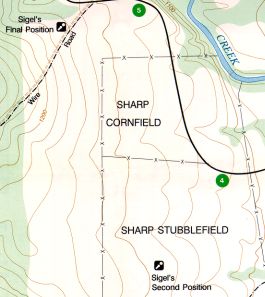Wilsonís Creek
With respect to the neutrality of Kentucky, the Confederates worked to gain control of Missouri. In Missouri, the contending forces were headed on the one hand by Governor Claiborne Jackson and other state officials, who were trying to take the state out of the Union, and on the other by Brig. General Nathaniel Lyon, commanding a small regular army force. Meanwhile, a Confederate force of from 10,000 to 12,000 troops under the command of Brig. General Ben McCulloch were moving toward Springfield, Missouri, where General Lyon was camped with his 5,400 Union troops.
Lyon was eager to engage the Confederates but frustrated that he was receiving no support from his departmental commander, General Fremont. His forces were joined in Springfield with those of Major General Samuel Sturgis, who had retreated from a skirmish with Gov. Jacksonís militia.
Determined to take the offensive, Lyon planned an advance against the Confederate forces under the command of McCulloch, which were camped at Wilsonís Creek, southwest of Springfield.
Lyon was to lead the main attack from the north, while Confederate Colonel Franz Sigel was to go around the enemy and attack from the south.
Lyon attacked, as planned, from the north at about 4:00 a.m. Surprised, the superior Confederate forces were forced to pull back.
At 5:30, Sigel was in position near Tyrelís Creek, and had placed a battery on high ground east of Wilson ís Creek where he could fire into the Confederate cavalry camp. When he heard Lyonís opening fire, he routed the Confederate cavalry and advanced toward a house owned by a man named Sharp. His troops proved no match for the Confederate forces of McCulloch, and by 11:00, Sigelís forces were out of the picture, and the Confederates were able to focus their attention on Lyonís troops. ís Creek where he could fire into the Confederate cavalry camp. When he heard Lyonís opening fire, he routed the Confederate cavalry and advanced toward a house owned by a man named Sharp. His troops proved no match for the Confederate forces of McCulloch, and by 11:00, Sigelís forces were out of the picture, and the Confederates were able to focus their attention on Lyonís troops.
By then, Lyon himself was dead.
On Oak Hill, Lyonís troops had repulsed two Confederate attacks, but Lyon himself has been wounded twice before finally being killed at about 10:30, when the third Confederate charge was underway.
Major Sturgis ordered a retreat to Springfield, a decision for which he was criticized.
Confederate Major General Sterling Price occupied Springfield, but did not pursue the Union army as they retreated to Rolla.
While the Battle of Wilsonís Creek was considered a Confederate victory, against far superior forces, the Union had seriously blunted the striking power of the Confederates, and the Union was able to hold most of the state of Missouri.
http://fhp.angelcities.com/wilsonscreek/index1.html
|

